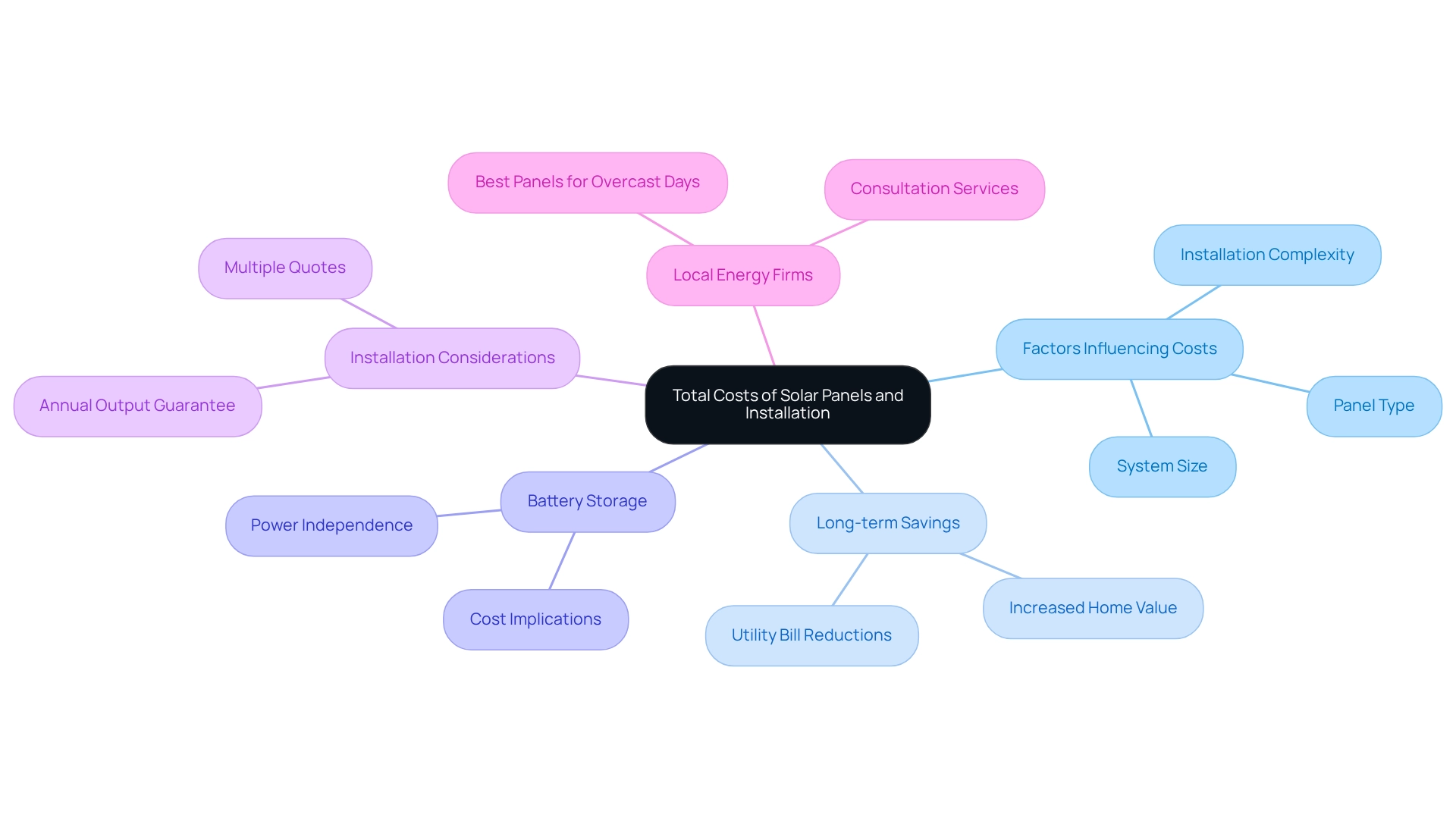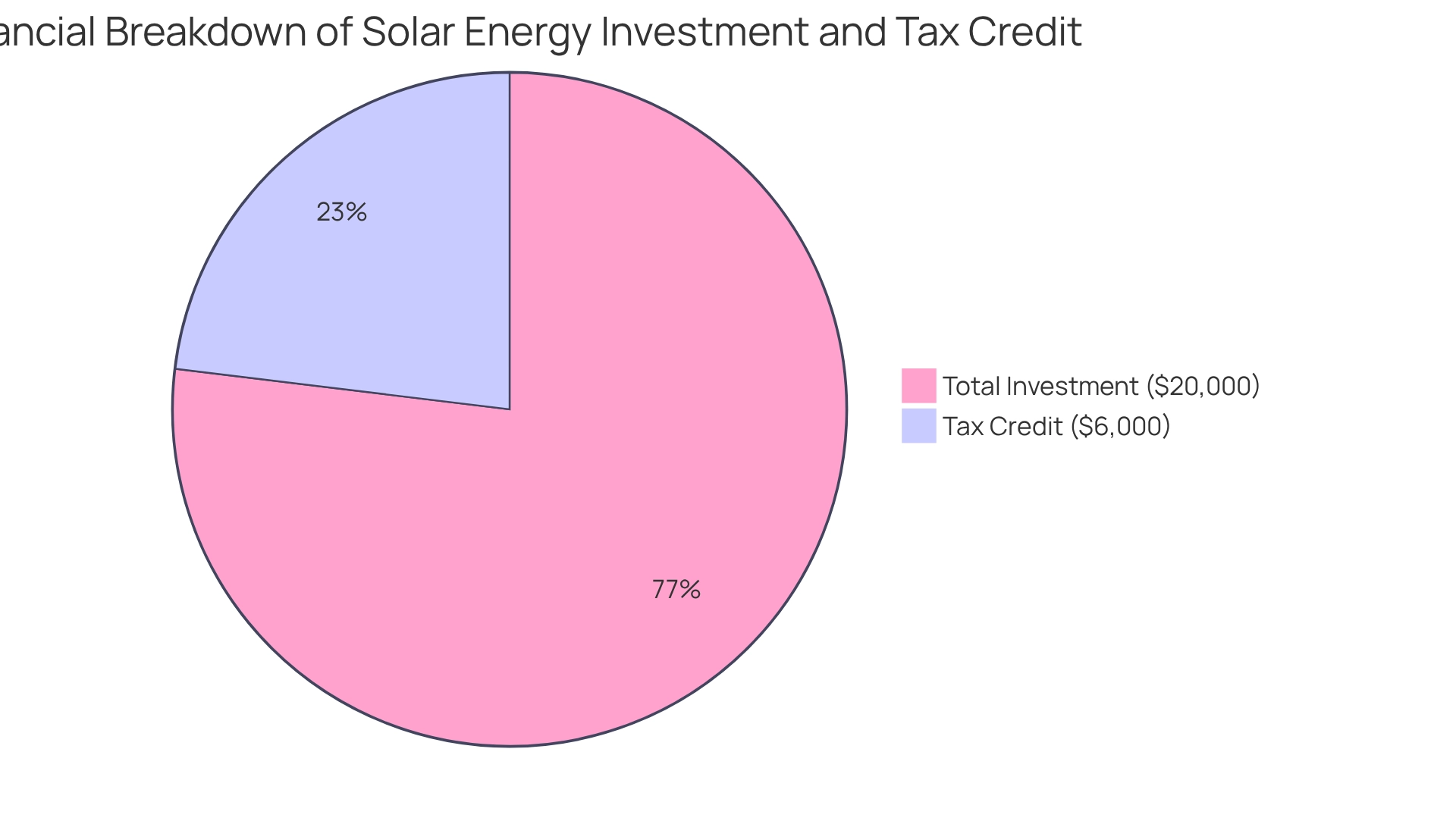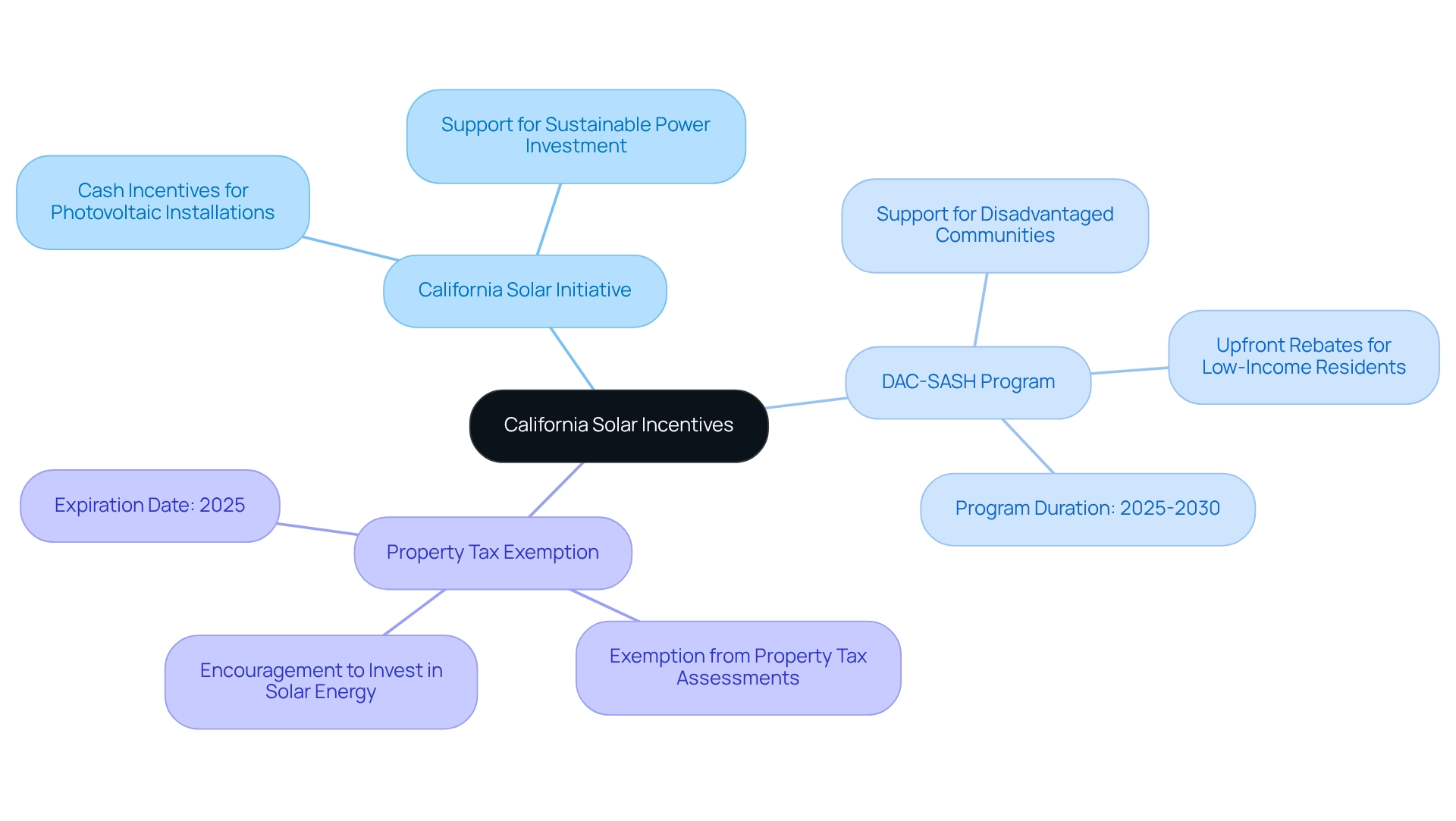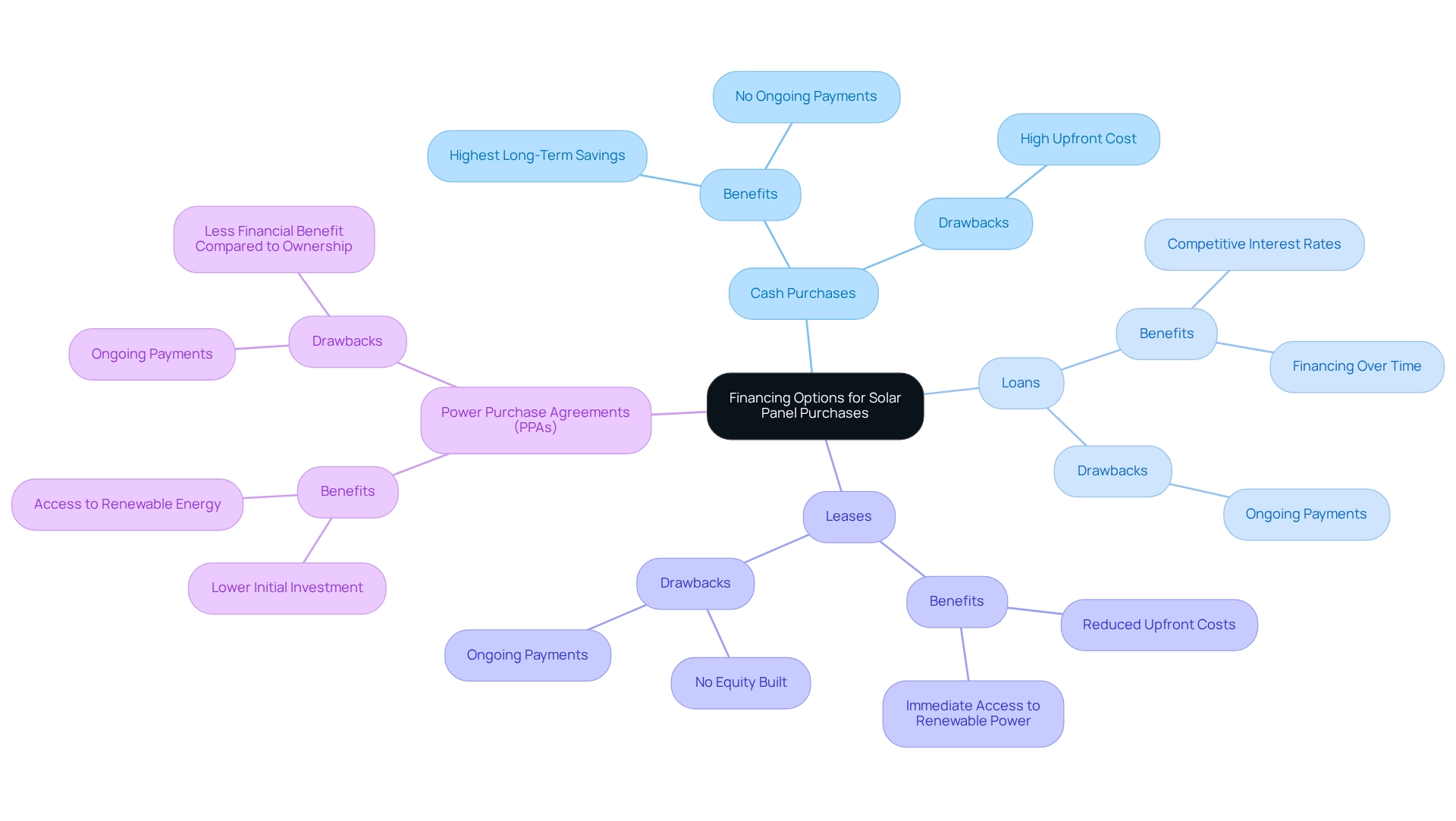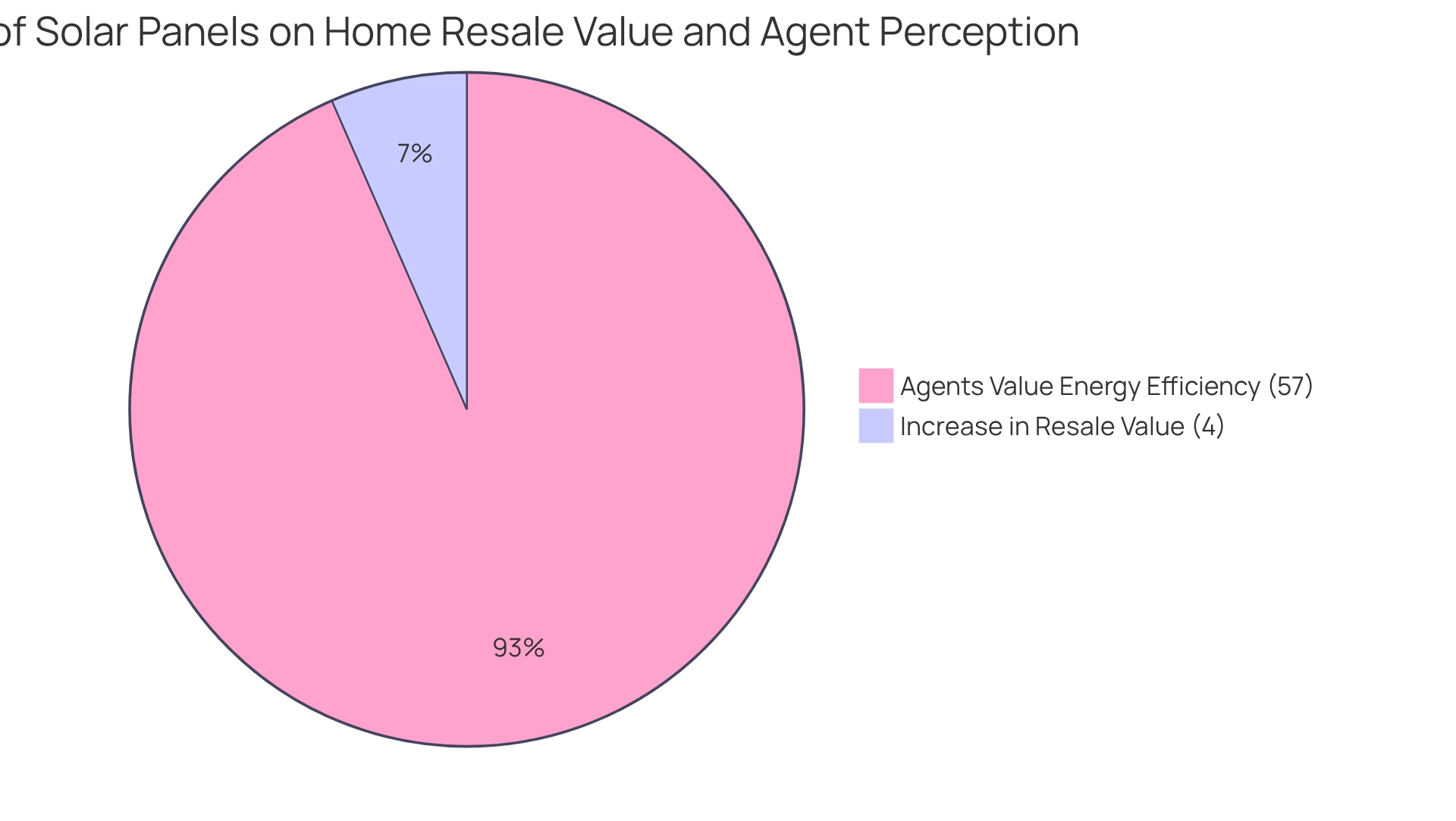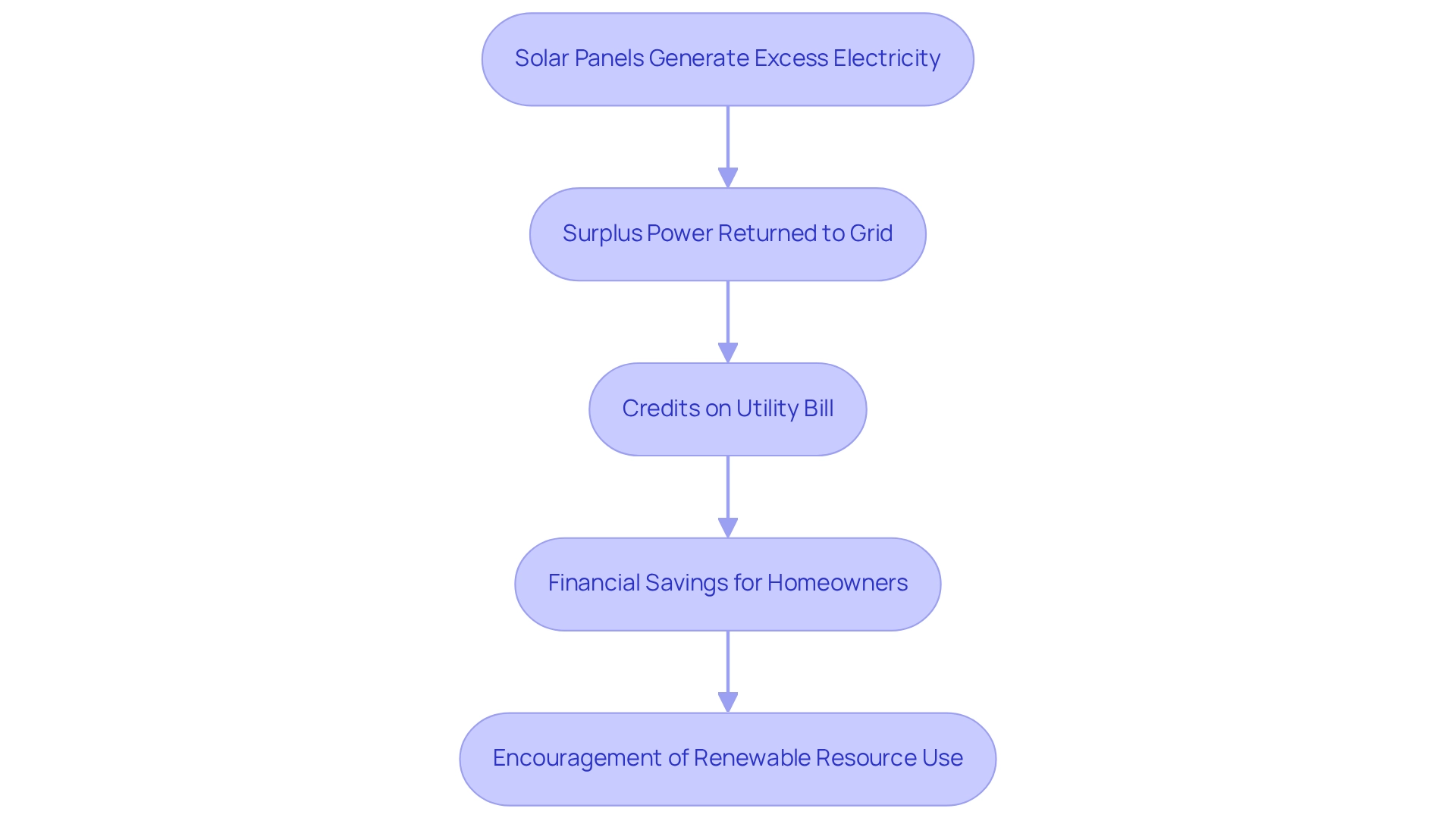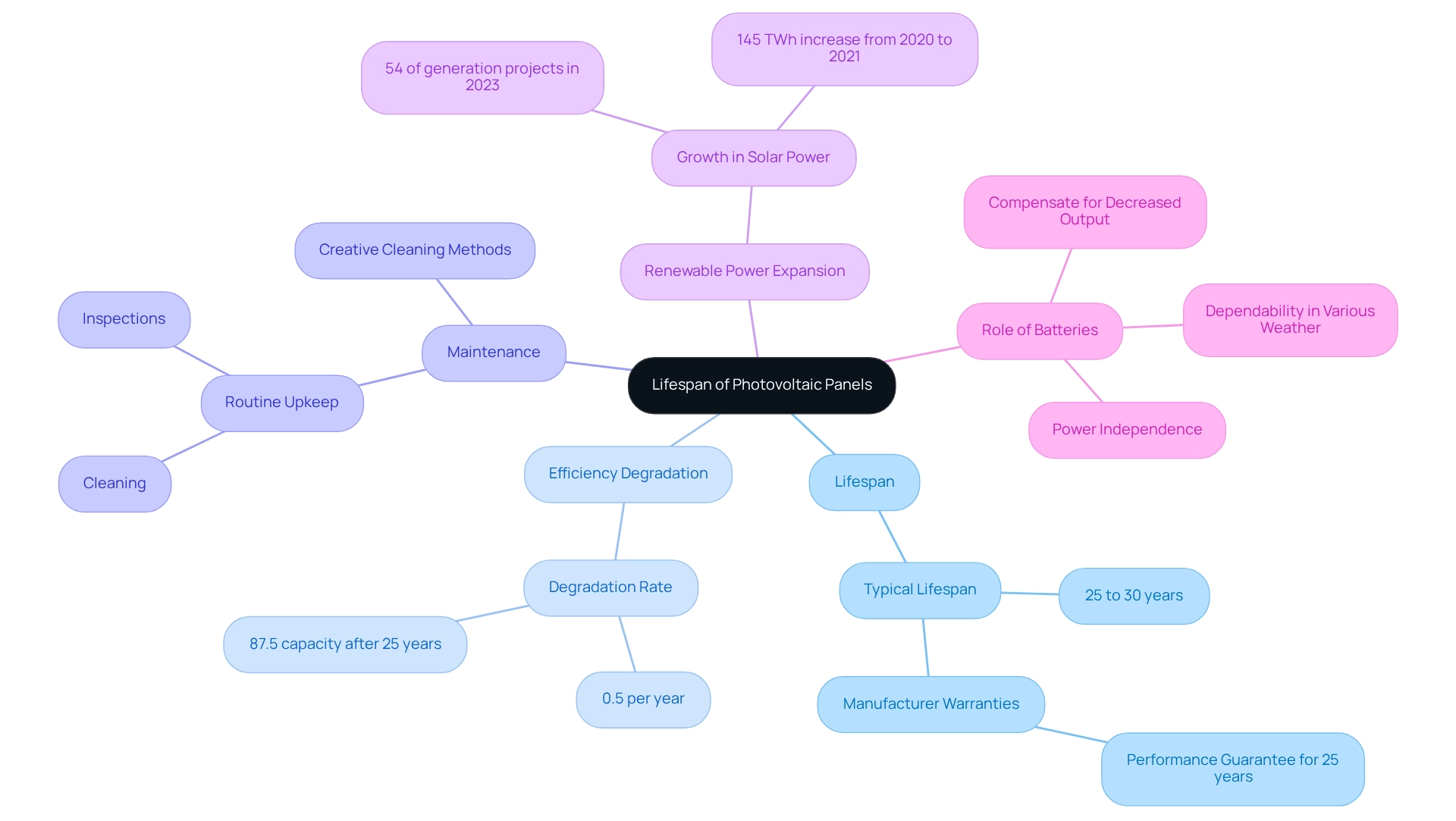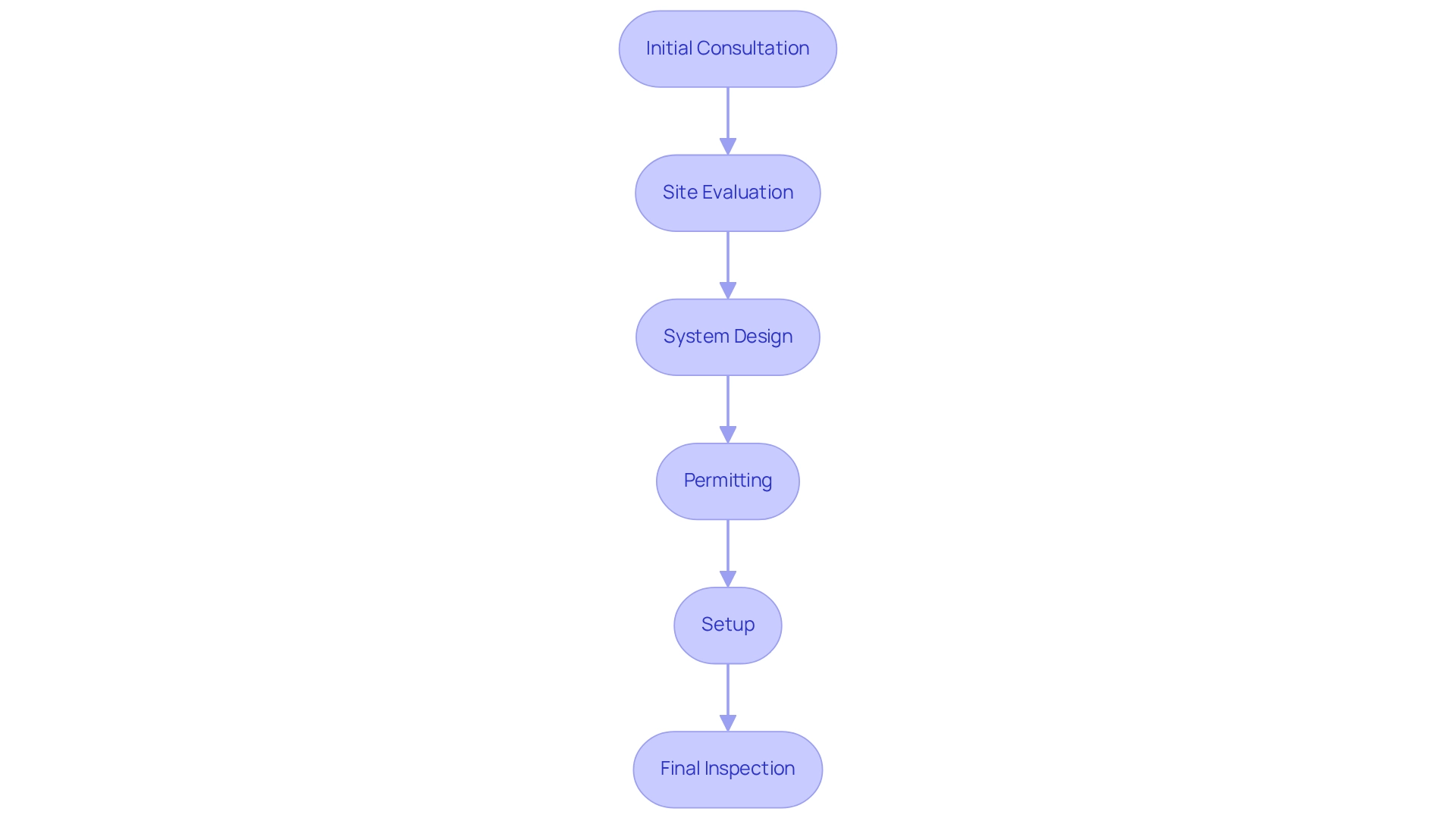Overview
As homeowners, we often find ourselves grappling with the rising costs of energy bills. It’s common to feel overwhelmed by the financial implications of purchasing a home, especially when considering the addition of solar panels. However, understanding the total costs associated with solar energy, including federal and state incentives, can empower you to make informed decisions that not only enhance your investment but also contribute to a sustainable future.
Choosing a reliable installer is crucial in this journey. We understand that navigating the installation process can be daunting, but know that there are resources and support available to guide you every step of the way. By investing in solar panels, you can enjoy the benefits of energy independence, reducing your reliance on traditional energy sources while also lowering your monthly expenses.
Together, we can explore how solar energy can transform your home into a beacon of sustainability. Let’s work towards creating a brighter, more eco-friendly future, ensuring that your investment is maximized and aligned with your values. If you have questions or need guidance, we are here to help you every step of the way.
Introduction
In the quest for sustainable energy solutions, we understand that many homeowners are concerned about rising energy bills and the impact on their carbon footprint. Solar panels have emerged as a beacon of hope, offering a way to reduce costs while nurturing our planet. However, it’s common to have questions about the costs, financing options, installation processes, and long-term benefits of going solar. This journey can feel overwhelming, but equipping yourself with the right knowledge can empower you to make informed decisions.
This comprehensive guide delves into the essential aspects of solar energy, addressing your concerns and providing valuable insights into financial incentives, installation longevity, and the positive environmental impact of embracing solar power. Together, we can explore how these solutions can lead you towards energy independence, ultimately guiding you to a greener future. Let’s work towards a sustainable lifestyle that benefits both your home and our planet.
What Are the Total Costs of Solar Panels and Installation?
We understand that there are important questions to ask about solar panels when buying a house, particularly regarding the overall expenses of photovoltaic panels and installation, which can be a significant concern for homeowners and often vary greatly due to factors such as system size, panel type, and installation complexity.
As we look ahead to 2025, property owners in California may find themselves investing considerably in a complete solar system, especially when considering the questions to ask about solar panels when buying a house, particularly if they opt for battery storage, which could lead to total expenses exceeding $38,000.
This trend reflects a growing desire for power independence and reliability, something many of us are striving for, and it’s important to consider the questions to ask about solar panels when buying a house to ensure you receive competitive pricing by gathering multiple quotes from various installers. This allows you to compare what is included in each estimate and consider the questions to ask about solar panels when buying a house to make an informed decision.
Additionally, don’t forget to consider the long-term savings on utility bills and the questions to ask about solar panels when buying a house when evaluating your initial investment. It’s worth exploring the idea of electrifying all aspects of your home and considering the questions to ask about solar panels when buying a house, as photovoltaic systems and battery storage can significantly enhance your overall efficiency and savings.
When entering into a lease for photovoltaic equipment, we recommend securing an annual output guarantee. This provides peace of mind regarding the system’s performance. Real-world examples highlight the importance of verifying production estimates, and independent organizations like the Energy Performance Validation Scheme (EPVS) can help confirm the accuracy of these claims, which are essential questions to ask about solar panels when buying a house.
This protection ensures that you’re not misled by inflated promises, which is crucial when considering the questions to ask about solar panels when buying a house, allowing for informed investment decisions. As photovoltaic technologies evolve, we anticipate that overall expenses will decrease, making solar energy an increasingly viable option for those of us pursuing sustainable solutions.
Moreover, reaching out to local energy firms in Stockton can provide valuable insights into the questions to ask about solar panels when buying a house, particularly regarding the best panels for overcast days from trusted brands known for their efficiency in less-than-ideal weather conditions.
We encourage you to connect with these local businesses for personalized guidance and potential installation services, ensuring your energy solutions meet your specific needs. Together, we can work towards a more sustainable future.
How Much Can Federal Tax Credits Reduce My Solar Costs?
In 2025, the federal energy tax credit allows homeowners to deduct 30% of their energy system expenses from their federal taxes. Imagine investing $20,000 in your energy system; this could translate to a tax credit of $6,000, bringing your net cost down to $14,000. This significant reduction highlights the financial advantages of embracing renewable sources. We encourage homeowners to consult tax professionals to fully grasp the implications of this credit and maximize their savings.
The impact of the federal tax incentive for renewable energy is evident in various case studies, where property owners have successfully lowered their installation costs, making this energy source more accessible. One case study illustrates how a homeowner saved substantially by utilizing the tax credit, emphasizing the importance of:
- Checking roof suitability
- Obtaining estimates from local energy providers
- Addressing the questions to ask about solar panels when buying a house
Resources like EnergySage can be invaluable in comparing quotes and selecting an installer, simplifying the journey for homeowners.
Currently, sunlight-derived energy accounts for approximately 3% of the United States’ energy generation. The tax credit is pivotal in encouraging its adoption by making energy installations more affordable. This incentive has been recognized as a policy success, reducing costs and strengthening the economy. As Johanna Neumann, Senior Director at Environment America Research & Policy Center, shares, “You can obtain tailored estimates from Energy Sage’s pre-screened installers, compare estimates, select an installer, and begin the installation of renewable energy panels on your rooftop.” By taking advantage of these credits, homeowners can transition to sustainable power options while enjoying significant financial benefits. Moreover, when comparing the costs of photovoltaic panels to traditional electricity, many homeowners find that the long-term savings from renewable systems can outweigh the initial investment, further enhancing the appeal of these alternatives.
What State and Local Incentives Are Available for Solar Panel Buyers?
As a California homeowner, you may be feeling the weight of rising energy bills, and it’s completely understandable. Fortunately, there’s a wealth of state and local incentives designed to encourage the use of renewable energy sources, which can significantly ease your financial burden. The California Solar Initiative, for example, offers cash incentives for photovoltaic installations, making it easier for you to invest in sustainable power. Additionally, local utilities frequently provide supplementary incentives that can further lower installation costs. With enough panels installed to power over 11 million households, California stands as a leader in adopting renewable resources.
Looking ahead to 2025, the state continues to support renewable energy through initiatives like the Disadvantaged Communities/Single-Family Solar Homes (DAC-SASH) program. This program offers upfront rebates for low-income residents in underserved areas, ensuring that everyone has a chance to benefit from renewable energy. As Sam Wigness points out, ‘The DAC-SASH program provides an upfront rebate for low-income residents in disadvantaged communities,’ highlighting its importance. This initiative is set to run through 2030, providing ongoing support for eligible households.
Moreover, California’s property tax exemption for photovoltaic panels is a significant advantage. This exemption prevents the taxable value of your home from increasing due to these systems, allowing you to invest in renewable energy without the worry of rising property taxes. However, it’s important to note that this benefit is scheduled to end in 2025, making it particularly advantageous for homeowners considering renewable energy installations.
At Powercore Electric, we care deeply about providing tailored energy solutions that meet the unique needs of homeowners across Northern and Southern California. We encourage you to explore local programs and consult with your installers, like Powercore Electric, to fully maximize the incentives available to you. By leveraging these financial benefits, you can enhance your energy independence while contributing to a more sustainable future. Together, we can take steps that lead to significant savings and a more eco-friendly home.
What Financing Options Are Available for Solar Panel Purchases?
Homeowners often find themselves grappling with rising energy bills and the desire for sustainable solutions. Fortunately, there are a variety of financing options available for purchasing solar panels, including:
- Cash purchases
- Loans
- Leases
- Power purchase agreements (PPAs)
Cash purchases typically yield the highest long-term savings, as they eliminate ongoing payments and interest, allowing you to enjoy the benefits of renewable energy without the worry of future costs.
Solar loans are becoming increasingly popular, enabling property owners to finance their systems over time, often at competitive interest rates that can be lower than those of traditional consumer loans. In 2025, average interest rates for renewable energy loans are projected to remain favorable, especially since mortgage interest rates for extensions are generally lower than those of consumer loans. This makes renewable energy loans an attractive option for many homeowners looking to invest in their future.
Leases and PPAs can significantly reduce upfront costs, allowing you to enjoy the benefits of renewable energy without the initial financial burden. However, it’s important to understand that these options may not provide the same financial benefits as outright ownership, as they often involve ongoing payments and do not build equity in the system. Assessing the advantages and disadvantages of each funding approach is essential for identifying the most suitable option for your personal financial circumstances.
For instance, a case study on photovoltaic panel systems shows that expenses can vary based on factors like system size, panel type, and roof complexity. Homeowners who received estimates from various trustworthy installers were able to compare pricing and financing options effectively, ensuring informed decisions. Professional guidance emphasizes that the optimal funding choice aligns with individual situations and financial objectives, highlighting the importance of thorough investigation and thoughtful consideration before making a decision.
As you evaluate your options, understanding the distinctions between renewable energy loans and leases is crucial. While loans provide ownership and potential savings, leases grant immediate access to renewable power with a reduced initial investment. Lenders that offer consumer-friendly features, including soft credit checks to pre-qualify, competitive interest rates, and flexible payment options, can significantly enhance your financing experience. Ultimately, the decision among these funding alternatives should reflect your long-term sustainability strategy and financial goals. Together, we can navigate these choices to find the best path forward for your energy needs.
Will Installing Solar Panels Increase My Home’s Resale Value?
Are you worried about rising energy bills? Installing photovoltaic panels can not only alleviate those concerns but also significantly enhance your home’s resale value. Studies show that residences fitted with renewable power systems sell for approximately 4% more than comparable homes lacking such features. This rise in worth is influenced by factors such as the scale of the solar system and current market conditions. As energy efficiency becomes a priority for many buyers, solar installations are increasingly viewed as a valuable asset. In fact, 57% of real estate agents believe that promoting a home’s energy efficiency, including renewable features, increases its market attractiveness, especially in a competitive market where buyers seek sustainable living options.
Imagine the long-term savings on utility expenses and the overall advantages of renewable energy. By informing prospective buyers about these benefits, you can build trust and satisfaction, ultimately leading to successful sales. Homes that have undergone renewable energy installations not only attract more attention but also command higher bids, reflecting the growing demand for energy-efficient properties.
We understand that making the switch to renewable energy can feel daunting. However, according to a case study on establishing trust with renewable energy clients, providing research-supported information about the advantages of this energy source can help foster that trust. It’s crucial for sellers to emphasize these benefits during the sales process. Powercore Electric’s commitment to outstanding service and regional expertise further enhances the value proposition for homeowners considering renewable solutions, ensuring they receive unparalleled quality workmanship and customer-focused service. Together, we can work towards a more sustainable future, making your home a beacon of energy independence.
How Does My Utility Provider Handle Solar Energy Production?
Utility companies in California generally adopt net metering policies that allow residents with photovoltaic panels to gain credits for any excess electricity produced by their systems. We understand that when solar panels generate more electricity than a household uses, the surplus power is returned to the grid, leading to credits on the homeowner’s utility bill. Grasping the details of your utility’s net metering policy is essential, as it directly affects possible savings and management strategies.
As of 2025, California’s net metering policies continue to evolve, reflecting the state’s dedication to sustainable resources. Homeowners can gain greatly from these policies, as they not only lower costs but also aid in creating a more sustainable future for resources. Many property owners have indicated significant savings on their utility expenses due to the credits obtained for surplus power generation. This shift to renewable power is becoming increasingly critical, particularly given the urgent necessity to cease supporting the fossil fuel sector.
Expert insights indicate that utility providers are progressively modifying their strategies to manage renewable power generation. They are implementing more advanced systems to account for renewable power effectively, ensuring that homeowners receive fair compensation for their contributions to the grid. This change is crucial for encouraging the use of renewable resources and improving autonomy in power supply. As Andrew Blake observed, “There is no shortage of solar and wind power … and prices are rapidly decreasing.” Together, we can create a clean power future at a modest cost if we desire.
Case studies illustrate the positive impact of net metering on homeowners. For instance, families who have adopted renewable power frequently share anecdotes of lower utility costs and enhanced dependability during blackouts, highlighting the dual advantages of financial savings and power security. The individual and worldwide influence of sunlight power underscores that embracing this resource is not merely a monetary choice but also a conscientious decision for future generations. As the demand for clean energy solutions increases, property owners should have a list of questions to ask about solar panels when buying a house, especially concerning how utility providers manage surplus energy production to optimize their investment in renewable technology.
Powercore Electric provides customized assistance for residents navigating the complexities of panel installations, including advice on comprehending net metering and the 200% rule. For those seeking assistance, a directory of top-rated, verified contractors for renewable energy is available to help homeowners find reliable service providers without feeling pressured.
How Long Can I Expect My Solar Panels to Last?
How Long Can I Expect My Photovoltaic Panels to Last?
As a homeowner, you might be wondering how long your investment in photovoltaic panels will truly last and how it can affect your energy bills.
- Lifespan: Modern photovoltaic panels typically last between 25 to 30 years, with many manufacturers offering warranties that guarantee performance for at least 25 years. This longevity can provide peace of mind as you consider sustainable solutions for your home.
- Efficiency Degradation: It’s common to feel concerned about efficiency over time. Photovoltaic panels generally experience a gradual decrease in efficiency, averaging around 0.5% per year. After 25 years, panels with this degradation rate can still function at around 87.5% of their initial capacity, ensuring that your investment remains valuable.
- Maintenance: Routine upkeep, including cleaning and inspections, is crucial for enhancing performance and prolonging the lifespan of photovoltaic panels. Creative cleaning methods can improve efficiency, guaranteeing that panels function optimally. Remember, taking these steps can significantly boost your energy savings and extend the life of your system.
- Renewable Power Expansion: As sunlight-based power rises as a prominent power source, it accounted for 54% of generation projects scheduled for 2023. Worldwide electricity production utilizing photovoltaic systems rose by 145 terawatt-hours (TWh) from 2020 to 2021. This emphasizes its increasing significance for homeowners investing in sustainable solutions. Together, we can contribute to a greener future.
- Role of Photovoltaic Batteries: These batteries are essential for compensating decreased output on overcast days, ensuring dependability in different weather situations and aiding in power independence. It’s reassuring to know that you can rely on this technology to keep your home powered, no matter the weather, and it is important for homeowners to consider the questions to ask about solar panels when buying a house to understand the durability and reliability of photovoltaic technology. If you have any questions or need support in making this transition, we’re here to help you every step of the way.
What Are the Environmental Benefits of Installing Solar Panels?
We understand that energy bills can be a significant concern for many homeowners. Installing photovoltaic panels is a wonderful way to lower your carbon footprint while utilizing clean, renewable resources. Solar power systems operate without generating greenhouse gas emissions, directly addressing climate change and enhancing air quality. By reducing dependence on fossil fuels, sunlight power helps create a more sustainable future. In fact, utilizing renewable energy for just one year is comparable to stopping the charging of about 937,683 smartphones, highlighting the substantial impact of this resource on reducing overall carbon emissions.
Experts emphasize the durability of solar panels, with installations lasting approximately 30 years, providing decades of carbon-free power. As industry leaders have noted, “Solar panels last approximately 30 years, which means one installation can supply carbon-free power for decades.” This long-term commitment to sustainability allows you, as a homeowner, to make a meaningful contribution to environmental protection for future generations. Moreover, regular upkeep and effective repairs of photovoltaic systems are essential to ensure peak performance, maximize savings, and enhance environmental benefits.
At Powercore Electric, we take pride in our local expertise and unmatched quality craftsmanship, ensuring that every installation meets the highest standards of quality, safety, and efficiency. Our customer-first approach guarantees that your satisfaction is our priority, making your experience seamless and stress-free. For instance, one of our customers in Southern California shared that they experienced a 30% decrease in their utility costs after installing our renewable energy system, showcasing the tangible benefits of adopting this technology.
As interest in renewable resources grows, community photovoltaic systems are expected to expand 20-30 times by 2030. This transition towards such solutions represents a collective effort towards a sustainable future. By choosing renewable energy, property owners not only enhance their autonomy but also actively participate in protecting the environment, creating a positive impact on their communities and the planet. Furthermore, under the 200% rule, homeowners can optimize their energy production, further amplifying the advantages of their investment. Together, we can work towards a brighter, more sustainable future.
What Should I Know About the Solar Panel Installation Process?
As a homeowner, you may often find yourself concerned about rising energy bills. The energy panel setup procedure is designed to address these concerns, encompassing several crucial stages:
- Initial consultation
- Site evaluation
- System design
- Permitting
- Setup
- Final inspection
Typically, this process can span from a few weeks to several months, influenced by project complexity and local regulations. It’s essential to work closely with your installer to ensure all required permits are obtained and that local construction regulations are adhered to.
Looking ahead to 2025, we expect the average time for panel setups to be optimized due to technological advancements and enhanced industry effectiveness. Successful implementations often showcase schedules that reflect a commitment to quality and regulatory compliance, ensuring you receive the best service possible.
A significant case study highlights the positive impact of the Inflation Reduction Act, which has not only encouraged the deployment of renewable energy but also sparked interest in U.S. energy production. This legislative support is anticipated to streamline the overall setup process, making it more accessible and efficient for you. With federal tax incentives available, expanding into the photovoltaic market becomes a more financially feasible option for many homeowners.
Moreover, it’s noteworthy that 80% of property owners choose battery storage primarily for its role as a backup power supply. This highlights the importance of integrating storage solutions into your photovoltaic setup. With enough photovoltaic systems installed across the U.S. to power 40.7 million homes, the magnitude of this renewable energy adoption is both considerable and relevant for prospective property owners like you.
Consequently, you can look forward to a more seamless installation process, with many projects completed in a shorter timeframe than in previous years. By collaborating with skilled installers who understand the nuances of local regulations, you can further expedite the process, allowing you to enjoy the benefits of renewable energy sooner. Together, we can work towards a more sustainable and energy-independent future.
How Do I Choose a Trustworthy Solar Panel Installer?
Choosing a dependable panel installer can feel overwhelming, especially when you’re concerned about rising energy bills. We understand that making the right choice is crucial for your peace of mind. Begin by evaluating the experience and knowledge of potential installers in the renewable energy sector, particularly in your local area. Look for those with a solid reputation, as evidenced by positive customer reviews and high satisfaction ratings. One satisfied customer shared, “Ryan and his team were great. They were quick, effective, and adhered to the timeline for our solar setup.” This reflects the exceptional service that Powercore Electric consistently delivers. Certifications from recognized industry organizations can also indicate a commitment to quality and professionalism.
Transparency is essential; a trustworthy installer should provide clear pricing structures and detailed service descriptions. We encourage you to request references from previous clients and take the time to read online reviews to understand their experiences. A reliable installer will provide a detailed proposal outlining the setup process, costs, and warranties, and will be open to addressing any questions to ask about solar panels when buying a house.
As we look towards 2025, customer satisfaction remains a vital metric, with many homeowners prioritizing installers who demonstrate reliability and quality service. The Renewable Energy Jobs Census highlights that setup and project development companies are crucial to the industry’s expansion, indicating a rising demand for skilled workers in this field. Additionally, 41% of participants indicated that permitting delays are a highly significant element, a crucial factor to consider when planning your setup.
As you navigate your options, consider these factors to ensure you choose an installer who aligns with your needs and values. Recall the sentiment of one participant who expressed, “It’s been a sunny coaster … I’m hoping that we’re beginning to truly move on an upward path.” This underscores the importance of selecting a trustworthy installer who can guide you through the process. Furthermore, allow approximately a week before and after the setup for scaffolding assembly and disassembly to guarantee a seamless experience. With over 30 years of experience in California, Powercore Electric ensures top-notch installations and maintenance through its in-house team of specialists, making them a dependable option for your energy requirements. To take the next step, reach out to Powercore Electric for a consultation and discover how they can assist you in your solar journey. Together, we can work towards a brighter, more sustainable future.
Conclusion
Investing in solar energy is a pivotal step towards achieving energy independence while making a positive impact on the environment. We understand that many homeowners are concerned about rising energy bills, and this guide provides comprehensive insights into solar panel installation. From understanding costs and financing options to exploring state and federal incentives, we aim to address your concerns and highlight the support available. Homeowners can benefit significantly from financial assistance, such as the federal tax credit and local initiatives, making solar energy more accessible and affordable.
Moreover, the long-term benefits of solar panels extend beyond immediate savings. Installing solar panels can enhance a home’s resale value, and with the longevity of modern solar technology, homeowners can enjoy decades of clean energy production. As utility providers adapt to incorporate solar energy into their systems, net metering policies offer additional savings by allowing homeowners to earn credits for excess energy generated. It’s common to feel overwhelmed by the installation process, but know that you’re not alone.
Ultimately, the transition to solar energy is not just a financial investment; it represents a commitment to a sustainable future. By choosing solar, homeowners contribute to reducing their carbon footprints and promoting a cleaner environment for future generations. Together, we can embrace the demand for renewable energy solutions and make informed choices about the installation process. With the right knowledge and support, the journey to a greener, more sustainable lifestyle is closer than ever. Let’s work towards a brighter future, where your energy choices reflect your values and aspirations.



